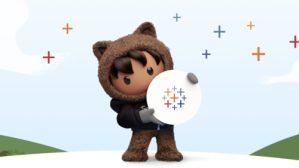In a world where data-driven decision making is critical to unlock operational efficiency and increased productivity, mining actionable insights from big data is crucial. The need is huge; no wonder big data and business analytics solutions are expected to generate global revenues of $189.1 billion this year.
But there’s a catch. Businesses are looking for smart solutions that provide data-backed insights without needing to jump into the complexities of analysing this data. How is this possible?
By enabling analytics anywhere, for everyone. And by providing visual, intuitive analytics in an end-to-end platform, surfacing insights and predictions in the flow of work that enable you to connect the dots between data and better outcomes.
This is exactly what Salesforce Tableau does.
What is Tableau?
As the world’s leading analytics platform, Tableau helps your team easily see, understand, and take action on their data, creating better, more effective business outcomes. .
Your organisation may have some tools so your team can see their data. But are they able to quickly explore this data, easily gain insights, and make smarter decisions—ones that enable improved growth, cost savings, efficiency, and productivity? With the broadest, end-to-end data and analytics platform, Tableau does just that: converting complex business intelligence into intuitive, visual insights that change the way your team analyses data. Not just a bunch of numbers put together in a table, Tableau dashboards are interactive, collaborative and can be customised with relevant business context, so that everyone—from business users to executives to analysts—can arrive at meaningful conclusions and actionable insights.
Tableau aims to democratise and automate data analytics with innovative, no-code, AI-powered solutions like machine learning (ML), natural language processing (NLP), smart data preparation, and more. With a proprietary query language (VizQL) at the heart of its functionality, Tableau effortlessly renders visuals of data sets with a simple drag-and-drop action.
Why is Tableau important for your business?
Consider this: the chief human resources officer (CHRO) for a multinational organisation has to create a hiring plan for the next year. The organisation has many branches around the country and every branch maintains separate, restricted employee data sets in different tools.
The result of not using a secure, scalable platform? Non-standardised data and the mishandling of private data could delay decision-making processes and create risks for the entire organisation. With the right governed data and relevant insights delivered in time and to the right people, the CHRO can:
- Get a comprehensive understanding of hiring by combining information from various sources
- Rapidly identify patterns in talent development across data sets
- Have more clarity about hiring targets and whether these should be met internally or externally
- Make provisions for future attrition and turnover
Tableau provides a holistic understanding of different types of data, enabling you to reach meaningful insights faster. Such data-driven insights can prove to be valuable in different areas of a business. Your sales and marketing teams need accurate, actionable data to determine their return on investment, identify trends, and make future predictions. Purchasing teams make timely decisions based on existing stock data. Leadership needs data about the company’s performance to present to investors. HR looks at recruiting, turnover, and development data to make personnel decisions.
Furthermore, a modern intelligence platform such as Tableau is designed for self-service analytics through an intuitive interface. The accessibility of no-code solutions, automated insights, and secure governance across levels lower the barrier to company-wide adoption and data usage, no matter the functions or department.
What can you use Tableau for?
With the help of Tableau’s powerful AI-enabled tools, businesses can perform the following functions:
- Data preparation – Tableau enables data gathering across formats (from a database to a spreadsheet) and sources (on-prem or in the cloud), and compiles them for analysis.
- Data exploration – Users can derive answers to specific queries from data sets. Tableau incorporates transparent AI into its platform, making it simple for everyone to understand how predictions and insights are derived and why they are important
- Data visualisation – The analysed data can be easily presented in the form of charts, histograms, graphs, and so on for easy understanding.
- Performance tracking – Historical data can be easily compared to current data to track and improve performance, and identify patterns.
- Mining – With AI-powered tools like machine learning and predictive modelling, Tableau enables users to make sense of large data sets.
Why should you choose Tableau as your data analytics solution?
Tableau comes with user-friendly functionality that makes it one of the most popular data analytics platforms for businesses. Here is how Tableau makes it easier for you to explore and manage data.
1. Allows you to self-serve: Tableau features an easy-to-use drag-and-drop interface that allows even novice users to perform rich analysis without coding skills.
2. Provides faster, deeper insights: Statistics, natural language, ML, and smart data preparation power augmented analytics in Tableau. This helps business users find answers and uncover insights more quickly. It also enables data analysts to perform complex calculations for detailed assessments.
3. Enables real-time collaboration: Tableau creates real-time business reports that the right people in the organisation can access when needed. With the tight Slack integration, you can create a digital hub for analytics – receive AI forecasts, get notifications for data-driven alerts, and collaborate on dashboards across teams and departments right in the flow of work.
4. Allows easy data visualisation: With interactive dashboards, Tableau presents relevant data in an easy-to-understand format on a single page. These dashboards can be created using point-and-click tools and out-of-the-box customisations and allow information gathering from various data sources. Additionally, thestored and processeddata can be visually represented using charts, histograms, graphs, etc., ensuring that employees across the hierarchy can easily understand the findings.
5. Enables data access on the go: Modern businesses operate across time zones, and executives need to be able to view, edit, copy and share data instantaneously to respond to business changes rapidly. Tableau lets you access data on any mobile device, such as a smartphone or tablet, so that data-driven decisions can be made anytime, anywhere.
6. Ensures secure data sharing: By leveraging data and content governance, Tableau puts in a place defined policies and procedures that provide a regulated yet flexible environment. This establishes trust and ensures responsible use of data.
7. Aids in better decision-making: Einstein provides predictions and suggestions within Tableau workflows for better decision-making. Data scientists, analysts, and business users can all produce effective prediction models without having to build algorithms. Developed by Salesforce, Einstein Discovery provides an intuitive environment where users are guided by transparent, ethical AI.
8. Creates a robust data culture: Tableau fosters a culture of data-driven decision making throughout organisations, ensuring adherence to the company’s values and ethos. Tableau offers the support of a large global community to each of its users. These powerful connections support your Tableau journey and help you learn more from the powerful resources at your disposal.
What Tableau products work best for your business needs?
Tableau has a host of products and services that can help you create a customised data analytics platform for your business needs. Take a look at some of them:
Tableau Cloud: A fully-hosted cloud solution that enables self-service, Tableau Cloud allows you to prepare your data, analyse, collaborate, publish and share your analysis from anywhere. A flexible, easy-to-use platform with real-time data exploration, it enables quicker, more reliable decision-making.
Tableau Desktop: Access, visualise, and analyse your data in a self-service, secure desktop environment. By using an intuitive drag-and-drop interface, you can get the hidden insights you need to quickly make significant business decisions, even when offline.
Tableau Server: Harness the power of your data by sharing it across the organisation in a secure environment with Tableau Server. Easy to deploy, integrate, and scale, Tableau Server ensures that your data and analytics are governed, secure, and accurate.
Tableau Prep Builder: With the help of Tableau Prep Builder, data can be combined, shaped, and cleaned more quickly and easily for analysis within Tableau. By providing visual aids and a direct path to prep your data, it can reduce data preparation time by nearly 60%.
Tableau Data Management: TDM allows organisations to scale data automation and operationalisation throughout the data and analytics lifecycle.
CRM Analytics: Get AI-powered predictions, recommendations, and contextual insights without having to leave your Salesforce CRM workflows by bringing all your data into your workflows. Quickly act on these insights by collaborating in Slack, updating records, and sharing dashboards. Plus, personalise analytics according to your business objectives and concentrate on the information you need.
Tableau: Using AI to turn data into insights
As the focus shifts from gathering customer data to developing customer intelligence, Tableau helps organisations across the globe transform the way they do business by making the most of their data. By combining insightful business intelligence with rich visualisations and powerful tools, Tableau can help any firm—from non-profits to global enterprises—churn out exceptional customer experiences.




























